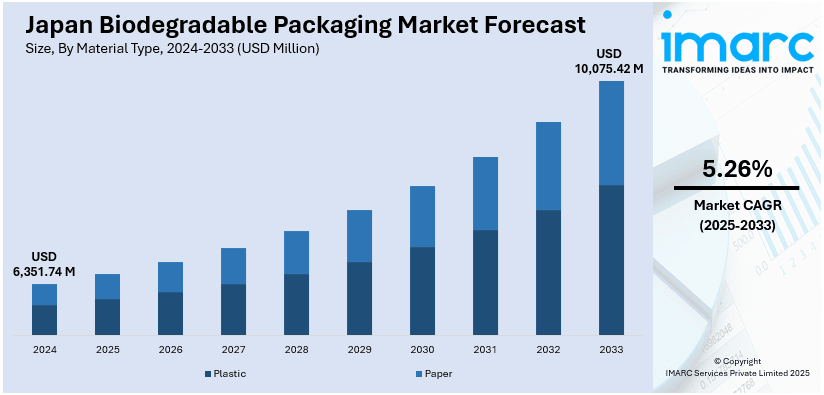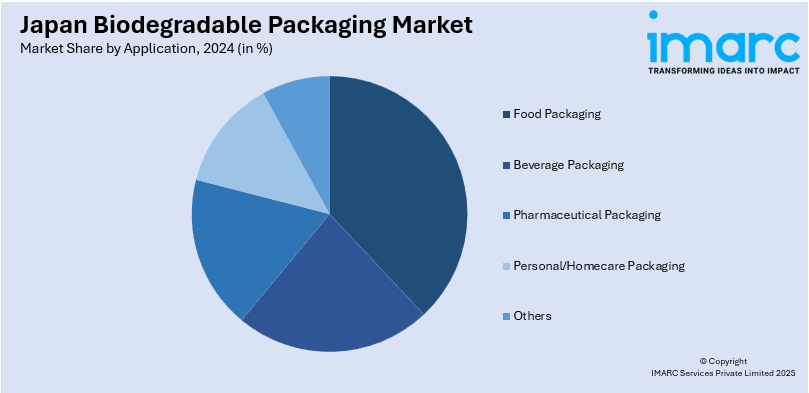
Japan Biodegradable Packaging Market Size, Share, Trends and Forecast by Material Type, Application, and Region, 2025-2033
Japan Biodegradable Packaging Market Overview:
The Japan biodegradable packaging market size reached USD 6,351.74 Million in 2024. Looking forward, IMARC Group expects the market to reach USD 10,075.42 Million by 2033, exhibiting a growth rate (CAGR) of 5.26% during 2025-2033. The market is driven by stringent government policies, such as the Plastic Resource Circulation Act, which mandates eco-friendly packaging adoption, alongside rising consumer demand for sustainable alternatives, compelling brands to shift toward biodegradable materials. Technological advancements, including marine-degradable polymers and bio-based composites, are enhancing material performance and cost efficiency, accelerating commercial adoption. Coupled with corporate sustainability commitments and R&D investments, these factors are further augmenting the Japan biodegradable packaging market share.
|
Report Attribute
|
Key Statistics
|
|---|---|
|
Base Year
|
2024 |
|
Forecast Years
|
2025-2033
|
|
Historical Years
|
2019-2024
|
| Market Size in 2024 | USD 6,351.74 Million |
| Market Forecast in 2033 | USD 10,075.42 Million |
| Market Growth Rate 2025-2033 | 5.26% |
Japan Biodegradable Packaging Market Trends:
Rising Demand for Eco-Friendly Packaging in Japan
The market is experiencing significant growth due to increasing consumer awareness regarding environmental sustainability. With Japan’s strong emphasis on waste reduction and circular economy initiatives, businesses are shifting toward biodegradable materials including PLA (polylactic acid), starch-based films, and cellulose packaging. Japan, with 87% reported rate of plastic recycling, faces challenges to achieving a true circular economy based on its reliance on thermal recycling (62%). While ambitious plans such as the 2022 Act on Resource Circulation aim for 100% recyclable or reusable plastic packaging by 2025, there is a wide gap between the set goals and material recovery in practice. As Japan heads towards cutting-edge recycling technology and waste reduction, the biodegradable packaging sector is emerging as a vital component in filling this gap. Government regulations, such as the Plastic Resource Circulation Act, are further accelerating this trend by encouraging companies to adopt eco-friendly alternatives. Major retailers and food service providers are leading the change, replacing conventional plastic with compostable and biodegradable options. Additionally, consumer preference for sustainable products is pushing brands to adopt greener packaging solutions to enhance their corporate image. As a result, manufacturers are investing in R&D to improve the durability and cost-effectiveness of biodegradable materials, making them more accessible for widespread use. This trend is expected to continue as Japan moves toward its 2030 sustainability goals, driving long-term market expansion.

Technological Advancements in Biodegradable Materials
The rapid advancement in material science, leading to more efficient and versatile biodegradable solutions, is propelling the Japan biodegradable packaging market growth. Innovations such as marine-degradable polymers and enhanced compostable films are gaining traction, addressing limitations of earlier biodegradable materials. Japanese companies are collaborating with research institutions to develop high-performance bio-based packaging that meets industry standards for strength, flexibility, and shelf life. Additionally, startups are exploring agricultural waste, such as rice husks and sugarcane bagasse, to create sustainable packaging. These technological improvements are reducing production costs, making biodegradable packaging more competitive with traditional plastics. Japan has been able to achieve its 2030 food reduction target in 2022 by lowering food waste to 4.72 million tons, which is lower than the set target of 4.89 million tons for that year. Importantly, 43% of household food waste comes from unopened or half-eaten products, so efforts towards longer expiration dates and more flexible delivery schedules have been responsible for making significant reductions. Due to the persisting problem of agricultural and food packaging waste, Japan's focus on biodegradable packaging is crucial for further reducing waste in the food sector. As Japan continues to prioritize sustainability, advancements in material technology will play a crucial role in shaping the future of the biodegradable packaging market, ensuring both environmental and commercial viability.
Japan Biodegradable Packaging Market Segmentation:
IMARC Group provides an analysis of the key trends in each segment of the market, along with forecasts at the country and regional levels for 2025-2033. Our report has categorized the market based on material type and application.
Material Type Insights:
- Plastic
- Starch-based Plastics
- Cellulose-based Plastics
- Polylactic Acid (PLA)
- Poly-3-Hydroxybutyrate (PHB)
- Polyhydroxyalkanoates (PHA)
- Others
- Paper
- Kraft Paper
- Flexible Paper
- Corrugated Fiberboard
- Boxboard
The report has provided a detailed breakup and analysis of the market based on the material type. This includes plastic (starch-based plastics, cellulose-based plastics, polylactic acid (PLA), poly-3-hydroxybutyrate (PHB), polyhydroxyalkanoates (PHA), and others) and paper (kraft paper, flexible paper, corrugated fiberboard, and boxboard).
Application Insights:

- Food Packaging
- Beverage Packaging
- Pharmaceutical Packaging
- Personal/Homecare Packaging
- Others
A detailed breakup and analysis of the market based on the application have also been provided in the report. This includes food packaging, beverage packaging, pharmaceutical packaging, personal/homecare packaging, and others.
Regional Insights:
- Kanto Region
- Kansai/Kinki Region
- Central/ Chubu Region
- Kyushu-Okinawa Region
- Tohoku Region
- Chugoku Region
- Hokkaido Region
- Shikoku Region
The report has also provided a comprehensive analysis of all the major regional markets, which include Kanto Region, Kansai/Kinki Region, Central/ Chubu Region, Kyushu-Okinawa Region, Tohoku Region, Chugoku Region, Hokkaido Region, and Shikoku Region.
Competitive Landscape:
The market research report has also provided a comprehensive analysis of the competitive landscape. Competitive analysis such as market structure, key player positioning, top winning strategies, competitive dashboard, and company evaluation quadrant has been covered in the report. Also, detailed profiles of all major companies have been provided.
Japan Biodegradable Packaging Market News:
- October 28, 2024: Suntory Group announced plans to launch the world's first commercial PET bottles made from bio-paraxylene from recycled used cooking oil. This new achievement is part of a bid to reduce CO2 emissions and encourage biodegradable packaging, with a starting point covering 45 million beverage bottles. Part of its commitment to sustainable packaging, Suntory intends to use only recycled or bio-based materials for all PET bottles globally by the year 2030.
Japan Biodegradable Packaging Market Report Coverage:
| Report Features | Details |
|---|---|
| Base Year of the Analysis | 2024 |
| Historical Period | 2019-2024 |
| Forecast Period | 2025-2033 |
| Units | Million USD |
| Scope of the Report |
Exploration of Historical Trends and Market Outlook, Industry Catalysts and Challenges, Segment-Wise Historical and Future Market Assessment:
|
| Material Types Covered |
|
| Applications Covered | Food Packaging, Beverage Packaging, Pharmaceutical Packaging, Personal/Homecare Packaging, Others |
| Regions Covered | Kanto Region, Kansai/Kinki Region, Central/ Chubu Region, Kyushu-Okinawa Region, Tohoku Region, Chugoku Region, Hokkaido Region, Shikoku Region |
| Customization Scope | 10% Free Customization |
| Post-Sale Analyst Support | 10-12 Weeks |
| Delivery Format | PDF and Excel through Email (We can also provide the editable version of the report in PPT/Word format on special request) |
Key Questions Answered in This Report:
- How has the Japan biodegradable packaging market performed so far and how will it perform in the coming years?
- What is the breakup of the Japan biodegradable packaging market on the basis of material type?
- What is the breakup of the Japan biodegradable packaging market on the basis of application?
- What is the breakup of the Japan biodegradable packaging market on the basis of region?
- What are the various stages in the value chain of the Japan biodegradable packaging market?
- What are the key driving factors and challenges in the Japan biodegradable packaging market?
- What is the structure of the Japan biodegradable packaging market and who are the key players?
- What is the degree of competition in the Japan biodegradable packaging market?
Key Benefits for Stakeholders:
- IMARC’s industry report offers a comprehensive quantitative analysis of various market segments, historical and current market trends, market forecasts, and dynamics of the Japan biodegradable packaging market from 2019-2033.
- The research report provides the latest information on the market drivers, challenges, and opportunities in the Japan biodegradable packaging market.
- Porter's five forces analysis assist stakeholders in assessing the impact of new entrants, competitive rivalry, supplier power, buyer power, and the threat of substitution. It helps stakeholders to analyze the level of competition within the Japan biodegradable packaging industry and its attractiveness.
- Competitive landscape allows stakeholders to understand their competitive environment and provides an insight into the current positions of key players in the market.
Need more help?
- Speak to our experienced analysts for insights on the current market scenarios.
- Include additional segments and countries to customize the report as per your requirement.
- Gain an unparalleled competitive advantage in your domain by understanding how to utilize the report and positively impacting your operations and revenue.
- For further assistance, please connect with our analysts.
 Request Customization
Request Customization
 Speak to an Analyst
Speak to an Analyst
 Request Brochure
Request Brochure
 Inquire Before Buying
Inquire Before Buying




.webp)




.webp)












